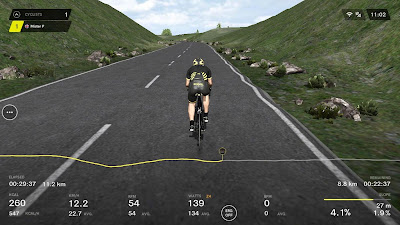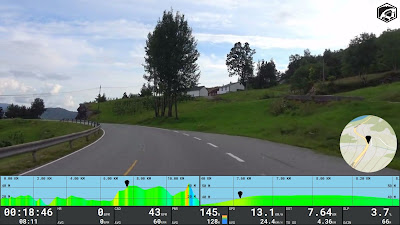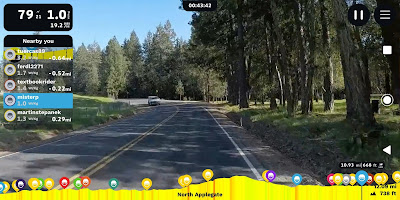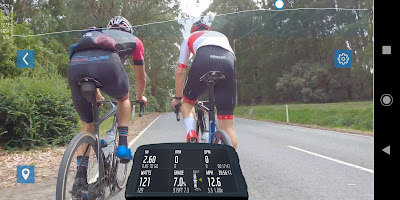If you have a turbo-trainer, chances are you've dabbled with a software solution, allowing you to cycle up steep climbs from the comfort of your conservatory, rumble over the cobbles of the Roublaix from your garage or maybe even cycle in fictional places, from the comfort of ... well, wherever. All you need is a suitably equipped (Bluetooth or ANT+) device, an app and a turbo, and suddenly you've entered the world of virtual riding. And who wouldn't want that? No surprise, then, there are more software choices out there than you can shake a stick at. But which is best? Well, I've tried a lot of them, including most of the biggest players and so a comparative review is in order. I'm not going to get bogged down in listing every feature of every option - they nearly all allow you to ride, compete and do workout sessions, most have some form of route editor option (though often in a separate app), most have video, most integrate with other services (Strava, Garmin and TrainingPeaks being the most common) - and besides, trawling through all that would take forever. Oh, and I'm just looking at virtual ride software and not virtual workout software (TrainingPeaks, for example) - I want to somehow visualise the virtual environment in which I'm riding, not just look at graphs.
In short, this review will focus on my general impressions, particular likes and dislikes, and the distinguishing features of virtual ride software because that's what I'm interested in. If you just want software to control your turbo for workouts, and are not bothered about virtual riding, go and download Golden Cheetah, it's good and it's completely free. Otherwise, read on...
Bkool is the software I've used the most, not least because a three-month premium subscription came with my turbo-trainer. I wrote a long review of it about a year ago (here) in which I raved about the hardware and was slightly less enthusiastic, but still quite positive, about the software. Well since then, Bkool have moved out of the hardware market, to concentrate on the software. And it has really paid off. Offering mostly animated renderings of virtual rides (though plenty have video available too), the simulator has a clean, clear interface and, crucially, for my money among the best, if not the best, variation of rolling resistance to match the virtual terrain. You really do need to use the gears. This, and a fairly well implemented ability to draught off other riders, make Bkool stand out.What else is worth mentioning? Well, it's also very keenly priced, among the cheapest of the serious options. And if that's not good enough, they do offer a limited free service. A couple of words to the wise on this though: the range of available rides for free users is very small and the free service doesn't synchronise to other services. It won't port your rides to Strava, in other words. They (rightly) know that this is a very important feature for a certain type of rider and so use that to steer users towards premium subscriptions.
TLDR: animation-based, with a fine interface and the best "cycle-feel" of any app I've tried, and good value too.
Price: 30-day free trial, then limited free service available, otherwise £7.99/mth or £78/yr
Platforms: Android, iOS, Mac, Windows - Bluetooth and ANT+ supported
BigRingVR is a bit different to most of the other software offerings discussed here today, in that there's no app or mobile version - you'll be lugging your laptop out to the pain cave. Also, there's no support for Bluetooth, so both your turbo and your laptop will need to support ANT+ (the latter usually achieves this with a dongle).Get those niggles out of the way though and BigRingVR has a couple of aces up its sleeve. First of all, there are the videos, for this is no animated solution: all the rides are in HD video, and they look fantastic. If you just want to ride up Alpe d'Huez and for it to look beautiful as you sweat, this should be a serious contender for you. There's also the interface, and detailed post-ride analytics (perfect if you're a data nerd, like me) - both are right up there near the top of the pack, in part due to the fact that they don't have to worry about scaling to smaller screens. In other words, they make the most of being a laptop/PC only solution. Oh, and you can sign in with your Google account, you don't have to create a BigRingVR account unless you want to, and that's a nice touch in this age of log-on proliferation.
Maybe it's the compunction to have HD video for every ride but, at the time of writing, there are only 435 different rides available, across 14 countries. That's not a lot compared to some of the other options here, but really, it's enough, isn't it, unless you're going to riding twice a day, every day of the year. Also, its US-roots are showing, not in the selection of rides, but in the dollars-only pricing model.
TLDR: beautiful ride videos, nice analytics and expansive interface, let down by no mobile device versions and no Bluetooth support.
Price: 14-day free trial, then $10/mth or $99.60/yr
Platforms: Mac, Windows - ANT+ only
I was excited to try the Tacx app, partly because they have got into bed with Garmin (meaning I could sign in with my existing Garmin account, rather than having to create another one for Tacx) and partly because their free offering still promised data export; whilst I'm quite keen on not paying for things, integration with Strava is a must-have feature for me, and maybe you feel the same.
I installed the Android version of Tacx, loaded it and logged in. However, as you might guess from the absence of a screenshot, I didn't get any virtual cycling done. Why? Because despite the Tacx website assuring me my trainer was compatible, the software just would not pair with my turbo. I tried and tried, to no avail. What a shame, because the software interface design looks lovely, the Garmin tie-in will appeal to many, and so will the feature-rich free version. But all of that is to no avail is the damned thing won't talk to your trainer.
Talking of pricing, if you are thinking about the Tacx software (most likely reason: you have a Tacx trainer) then it's worth noting there are two levels of paid subsciption: Premium and Premium HD. The former adds videos (notably absent from the free service), GPS imports for your own routes, and a workout library. The latter just adds HD video to that. I would suggest, then, that Premium is priced appropriately and that Premium HD is over the odds.
TLDR: good-looking app, and Garmin tie-in should make it popular. It has to work for you though! HD video option is pricey.
Price: 30-day free trial, then limited free service available, otherwise €9.99/mth or €99.99/yr for Premium, €13.99/mth or €139.99/yr for Premium HD
Platforms: Android, iOS, Mac, Windows - Bluetooth and ANT+ supported
There's a lot to like about Rouvy. Its features list is akin to Bkool, whilst its interface design aspires to the colourful palette and rounded corners of Zwift. A lot of thought has gone into making it both look good and work well. And compare Rouvy's 4000+ videos to, say, BigRingVR's 435 ... with Rouvy, you basically need never ride the same route twice.As well as all the video, Rouvy also offers what it calls augmented routes, in which 3D avatars for other riders are dropped into the video. It's a clever feature, but for me feels a bit gimmicky, and the mix of real video and virtual competitors felt a bit off - I reckon animated competitors work best in an animated setting, but I guess I might just be a bit old-school.
Another thing that might be "just me" was the need, on many occasions, to drop out of the video view of my route and switch to the map view because the video stopped streaming. I actually quite like the map view, it gives a sense of place in the world that appeals to the cartophile in me, and it's great that Rouvy provides this option. But to have to switch to it because streaming stopped was not ideal. At least the ride carried on when the streaming fell over... although that was weird in itself, to see the distance travelled continue to increase whilst appearing stationary.
Another plus for Rouvy is its pricing model, specifically family sharing. One subscription can be shared by up to three family members, which might be attractive if you and your significant other are both hardcore virtual cyclists. Each family member needs their own Rouvy account still, then whichever one pays for the subscription sets up the share. It's a nice touch.
TLDR: good-looking app with attractive features list, with pricing to appeal to cycling couples and families. Occasionally glitchy connection.
Price: 14-day free trial, then $15/mth or $144/yr but subscription can be shared with two other family members
Platforms: Android, iOS, Mac, Windows - Bluetooth and ANT+ supported
See also: B'Twin training, KETTMaps and BH, as these are all just skinned versions of the Kinomap app.
I was excited to try Kinomap, in part because, from what I could see, it is one of the longer-established virtual ride software offerings. I figured, they've been doing this a long time, they should have got it right by now. The fact that they skin their app, and offer it to other providers, surely speaks of its quality too, right? Well, maybe.
So what can I tell you? As with the review of Tacx, above, you might have noticed the absence of a screenshot. That's because, although the app installed easily enough, once more I could not get it to pair successfully with the turbo trainer. And in case you think I'm using some obscure hardware, let me clarify that I'm really not, it's a Bkool Smart Pro 2 and supports Bluetooth and ANT+. But for whatever reason, Kinomap just would not pair with it. And that's a shame, because on paper it's fully featured, has a nice clean interface (pretty much half way between Bkool's simplicity and Rouvy's Zwiftesque styling) and has the all-important integration with other services. Everything you want, basically... but that counts for nothing if it wont pair with your hardware, and this is especially annoying as you have to go to the trouble of creating an account with them before you can discover that it won't pair. Cue the tedium of uninstalling and account deletion. And it's not just me - looking at the spectrum of apps on the Google Play Store, Kinomap has amongst the worst review average ... unless you count its skinned derivatives, which are worse still. In the interests of balance, I should add that the iOS version is very well reviewed. Make of that what you will.
On the plus side, if you can get Kinomap working for you, they at least offer a lifetime subscription for less than the cost of three years regular subscription. That might be worth a look if you're going to get long-term serious.
Oh, and a footnote: the Kinomap online compatability checker suggests that their app will only pair with my trainer using ANT+, not Bluetooth... even though the trainer supports both, and the app supports both. Why's that? My phone doesn't natively support ANT+, not without tweaking under the bonnet, so maybe that's the issue. And maybe that would be an issue for you too.
TLDR: nice blended interface that makes the trial worth a look. Connectivity might be a problem though, and I can't comment on the ride.
Price: 14-day free trial, then €9.99/mth or €79.99/yr ... or €229 for life!
Platforms: Android, iOS - Bluetooth and ANT+ supported, though not for all hardware, it seems
Now here's an interesting one. The FulGaz USP is the quality of their videos - there are no hokey animated rides here, it's all HD video. Not only that, it's shot by cyclists, often with other cyclists around; those aren't avatars in the screenshot, but real riders. The upshot of this is that you really feel like you're in the ride, more than most other software reviewed here. And with sound turned up, you hear the visceral whoosh as you charge downhill (and when a lorry barrels past you too, by the way!)...which is all well and good except that I had connectivity problems. Weirdly, FulGaz would detect some sensors on my trainer and not others, the notable omission being the power sensor. Turns out my turbo trainer is not officially supported. The upshot of this is that I could ride fine, record time and distance, but the variation of resistance just wasn't there. I sort of worked around this by starting in a modest gear and then shifting up and down to vary resistance manually... but that's not right, is it? And I wouldn't be happy with that if I was paying for the service, rather than experimenting with a free trial. Too much realism is lost, this way; whilst I completed a 22-mile sprint event in 50 minutes, I couldn't be pleased with that, knowing that I wouldn't be able to do so in real life (especially not on the old clunker that is currently hooked up to my turbo).
There are some other noteworthy features - the interface, for example, is minimalist and clean, the on-screen "cycle computer" view shown being the default. You can have a more "heads-up" display if you want, and overlay a map, but if the selling point is trying to make it look and feel like you're really cycling, then what's the point of that?
TLDR: the sensory side of riding is as real as anything here, but that counts for nothing if it can't accurately reflect the effort you're putting in.
Price: 14-day free trial, then £9.99/mth or £85.99/yr - subscription can be shared with one other family member
Platforms: Android, Apple, iOS, Windows - Bluetooth and ANT+ supported
Here's another one that I was really looking forward to reviewing, but you know the drill by now: no screenshot means I couldn't get it working, and that's a shame. This platform does things a little differently, relying on two apps: one for your smartphone, to use as a remote control, and one for your laptop to act as a display device. Maybe it's a good idea, maybe it's an over-complication, I can't say because I couldn't get the damned thing going. Installing the control app to my Android smartphone was no problem at all, but the display app was a different kettle of fish; it requires a minimum Windows 10 build of 17134 (higher than the RGT website claims, by the way). Now my personal laptop has build 16299, so no joy there, and my work laptop will only install from an employer-approved subset of the Windows store, which doesn't include RGT. I was all out of luck basically. Not sure what build of Win10 you have? They're listed here, and this is how to check your machine.
Despite my reservations about the technical set-up (take two devices into the pain cave?, a reference for readers of a certain vintage), the reason I was so keen to take a look at RGT was that it is touted as the best virtual ride experience you can have for free. That's subjective, obviously, but unlike some of the other software here with free options, free RGT still integrates with other services, like Strava. In other words, it seemed tailor-made for yours truly. And even the paid service option is cheap.
TLDR: good-looking applications, plural, that might suit if you can be bothered setting two devices up (and upgrading your operating system) or if you're looking for a feature-rich free ride
Price: 14-day free trial, then limited free service available, otherwise £6.99/mth
Platforms: Android or iOS for mobile app, Mac or Windows for display app - Bluetooth and ANT+ supported respectively
And so we come to the daddy of them all; Zwift seems far and away the most popular software solution for virtual riding, if the people I follow on Strava are anything to go by. And they know they're the most popular, hence the short trial and price premium: £156 a year is a lot. So what makes it special, and is it worth it? Well, Zwift majors on providing something a little different to the other software here; sure, it offers virtual rides and workouts but also, more than anything else on this page, pushes the social aspect of virtual riding. You can have Zwift meet-ups with your mates, just like you might in real life. And not only that, if you want to ride along with a pro cyclist, this is the place to do it. Okay, other platforms hosts similar events, but they don't have the traction or market share of Zwift. And other platforms aren't as slick either, for Zwift is highly polished: for example, if you mute the sound, it doesn't just cut off but fades out. That's polish. Part of the reason Zwift is such a big download is all that polish... but it's arguably worth it, for the interface is clear, colourful and, dare I say it, fun? I personally prefer the low-key (older?) interface of Bkool, but from a UI design perspective, you can't help but admire the youthful exuberance of Zwift.But enough of the USPs, what about actually using the app? Well, you get to ride as an avatar in virtual representations of real routes or, uniquely, in the fictional landscape of Watopia. The interface is bright, colourful and rounded, making it feel more like a game than the austere world of Bkool and BigRingVR. And that's the point, isn't it? Who hasn't been out on a real ride, seen another cyclist whizzing along and thought, "Right, I'm going to ride them down"? After all, what makes Strava so popular, if not segment times, leaderboards and the promise of KOMs? Zwift channels that same innate competitive feeling into its platform, gamifying the virtual ride experience in the process. It's effective, compelling and potentially slightly addictive.
Downsides? Well, there's a lot going on? Giving "ride on" high fives to passing cyclists, collecting power-ups (like making your bike lightweight for a spell), unlocking achievements... it can all get a bit hectic. Although if you can tune that out, none of the bells and whistles get in the way of the cycling. Oh, and if only it wasn't quite so expensive...
TLDR: it's the daddy for a reason. If social cycling and competition rank high among your motivators, you need to give this a whirl
Price: 7-day + 25km free trial, then £12.99/mth
Platforms: Android, iOS, Mac, Windows - Bluetooth and ANT+ supported
The verdict
Well, the verdict is clear and it's this: unclear! You need to pick a package that works for you, i.e. delivers an interface to your taste, offers the feature set that you need, integrates with what you need it to, and that talks to your hardware (trainer and smartphone/laptop). For what it's worth though, here are my thoughts:
- Best feature set: Bkool
- Best interface: Bkool if you like your interfaces minimal, Zwift if you prefer some zing
- Best analytics: BigRingVR
- Best physical (resistance) simulation of riding: Bkool
- Best visual (sensory) simulation of riding: Rouvy
- Best social/community features: Zwift
- Best value: Bkool for individual cyclists, Rouvy for couples/families
- Best all-rounder: well, that's the $64,000 question...
...because there isn't one best application, no overall winner. Some stand out, and for me it's a toss-up between Zwift as the social, hip, hyped and occasionally hectic choice and Bkool as the serious (and less social) virtual riding pick. Which you prefer will come down to what you're looking for from the virtual riding experience and what motivates you. It may also come down to your budget, as there's £5 a month difference between the two. Oh, and I should also note an impressive showing from Rouvy, highly commended and third place in my book.
One more thing: it's worth remembering that, if you have a Wahoo bike GPS, you don't need any fancy software to run your turbo trainer, as you can use that to recreate routes with accurate resistance variation, do workouts, and a whole lot more, for free... you just won't have a pretty interface, animated competitors, video routes or anything else to look out. But it is very do-able, as well described in this video from SmartBikeTrainers.com, and is the best value option of all, because who doesn't like free?





No comments:
Post a Comment